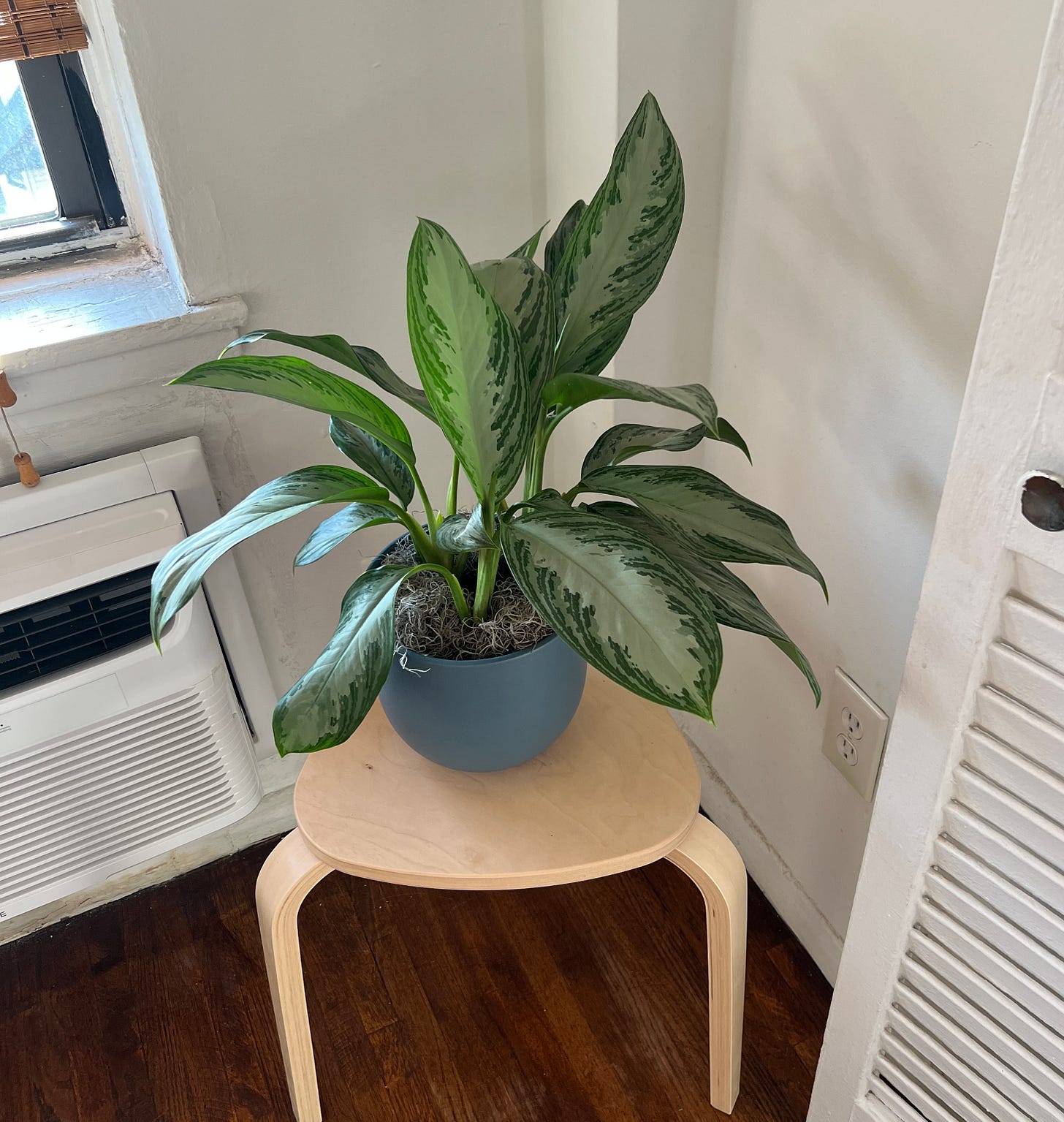Pruning your business for growth
Knowing when it's time to trim and how to go about it.
A few months ago, I shared a post about feeling the need to update my home after returning from my travels at the start of the year. In it, I spoke about being with the discomfort of removing items that no longer fit my life, and then not rushing to fill the space opened up when they were gone.
Well, actually, just one item… a chair that sat in the corner of the living room. After several days, it became clear that what I wanted there was a plant, placed on a simple stool. As I mentioned, I have a history of having a less than a green thumb, so I was a bit nervous and followed the care directions to a tee. And alas, the plant is still alive and appears to be thriving. There have been two new shoots that fully sprouted into leaves, and one new shoot just emerging — a win in my book.
There was also one large, fully formed leaf that didn’t make it. I watched as it slowly turned a yellowish shade of brown from tip to stem. And I knew it had to go, both aesthetically, as well as for the health of the plant.
It was time to prune.
Why pruning is necessary.
Before I dove into the “how,” of pruning, I wanted to know the “why.”
“Pruning is important for plant health, safety, and aesthetics. It involves removing dead, damaged, or diseased branches, which helps the plant redirect its energy towards healthier growth and prevents the spread of diseases. Pruning also improves the structure of the plant, encourages better light penetration, and can stimulate new growth.” ~ The Joe Gardner Show
It’s the same in our businesses. We nurture them, feed them, take in nutrients from other people (ideas, courses, programs, the latest trends, new tools, new ways of working, new clients), and we grow. Then at some point, growth slows or moves too far ahead of us. Either way, something starts to feel off. We know it in our gut. It’s pruning season.
When is the best time to prune?
When it came to removing the once-vital, now-dead leaf, I searched for advice on the right way to do it. This was a spot removal (daily pruning), which I learned is different than pruning season. The latter being a more intentional approach to trimming for renewed growth.
It turns out that both seasonal pruning and daily pruning are necessary for the health of the plant:
“Some tasks, when it comes to trimming and pruning houseplants, should be done during certain times of the year. It’s best to get any large amounts of pruning done during the spring or summer, when your plants are getting more sunlight and are actively growing. Trimming off a large amount of leaves, branches, or anything that will cut back a sizable amount of your plant, is best done during this time. In general, you don’t want to remove any more than 1/4 of the overall foliage of the plant.
Hold back on any major pruning during the fall and winter — your plants won’t be growing as quickly, and it could take a longer time for them to put out new growth or recover from being trimmed too much. However, there are tasks that can easily be accomplished during any time of the year. Pulling off yellowing or brown leaves, trimming away a few stems or vines, or other smaller items, can all be done daily or as needed throughout the year to keep your plants looking healthy.” ~ Stump Plants
I like this analogy — combining thoughtful removal throughout the year of small things that are no longer working in order to keep a business fresh, open to opportunities, and thriving, AND doing a larger, intentional prune when a business slows, is growing too quickly, or is ready for a pivot.
What it means to thoughtfully prune your business.
Pruning isn’t just about cutting back. It’s about making intentional decisions so your business can keep growing in a way that’s healthy, sustainable, and aligned with where you are now, not where you started.
Just as with plants, there are two types of pruning in business: small, in-the-moment trims and bigger, more intentional cuts.
Daily pruning is subtle and ongoing.
These are small moves that shift your energy and, as a result, the course of your business.
Some examples:
It’s the email you no longer feel obligated to reply to.
The recurring meeting you cancel because it’s not serving a purpose.
The idea you jot down and deliberately don’t act on, because just because you could doesn’t mean you should.
It’s choosing not to follow every trend.
It’s catching yourself before you say “yes” out of habit.
It’s being present enough in your day-to-day to notice what’s adding value to your business (and life) and what’s just noise.
These are small adjustments that keep your energy clear and your business responsive and healthy in the day-to-day, so your energy isn’t wasted keeping something alive that’s already on its way out.
Seasonal pruning is more deliberate.
It’s the step back. The slow scan. The honest look at what you’ve built and whether it still fits the business (and life) you want now.
It’s not reactive, it’s reflective. It’s when something bigger feels off:
You’re fully booked but not excited.
Your audience has grown, but your message hasn’t evolved with it.
You’ve built a business that works on paper, but no longer feels like yours.
This is the time to reassess your offers, pricing, and positioning:
Quietly sunsetting a service that’s no longer selling.
Or restructuring those that are.
Changing your pricing or pricing model.
Letting go of a client who’s no longer aligned and is draining your mental and emotional resources.
Stopping the weekly newsletter that’s become a chore.
Ditto the social media posts.
In the process, you acknowledge the parts of your business that served you well, but no longer reflect what you want, how you want to work, or what’s most needed now.
It takes more thought, more space, and usually a heck of a lot more courage. But what you get in return is worth it. You get renewed clarity and intentional, renewed growth. Pruning in this way is not about what's failing. It’s about making room for what’s next.
And yes, sometimes there’s discomfort in the process (I know that first-hand). It can be hard to cut back something that once felt full of life and possibility. But if it’s no longer working, it’s time to go. Just because something used to belong doesn’t mean it still does.
Now what?
Whether you’re in a season of small, quiet trims or you’re feeling the call for to make some bigger moves, pruning isn’t about loss. Like a good haircut, it’s an act of (self) care, but in this case for your business. It makes space for your next stage of growth.
With that in mind consider these questions:
What are you maintaining out of habit, obligation, or fear that no longer fits where you're headed?
What part of your business felt right when you started, but feels heavy, outdated, or disconnected now?
Where are you spending energy that isn’t creating momentum, meaning, or return professionally and personally?
What’s quietly draining you and what might shift if you let it go?
Choose one small thing to trim this week. It could be a habit, task, or commitment that no longer feels necessary.
Then, identify one bigger area that may need a seasonal review. You don’t need to take action just yet, instead just name it. As they say, awareness is the first step.
Until next time.
Katherine
#ICYMI











This was an awesome read Katherine! Never heard of pruning before but I’m glad I learned about it! This reminds me of efficiency and that’s been something I’ve been trying to improve especially this year. It feels pretty freeing to get rid of all the unnecessary fluff and just focus on what yields you the most results.💪❤️
Great connection. I saved the prompts to consider this weekend.